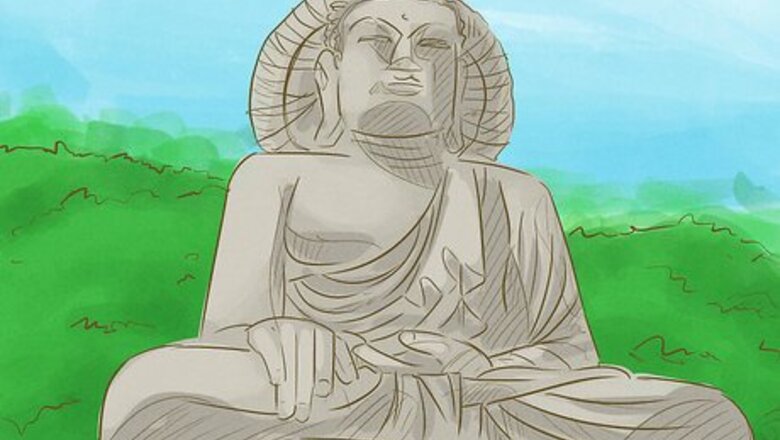
views
Studying the Taekwondo Philosophy

Understand Taekwondo’s religious and philosophical influences. Buddhism, Confucianism, and Taoism are the main influences of Taekwondo. Each one of these religions teach people to be altruistic, to help their fellow man, and to avoid needless conflict. Korean Buddhism is a strain of the Mahayana tradition and dates back to the 4th century. It stresses thoughtful contemplation and the recognition of suffering. The Buddhist insistence on non-violence is probably its most profound influence on Taekwondo. Confucianism made its way into Korea gradually around the 3rd-2nd century BCE. Confucianism is often considered to be as an ethical and philosophical system more than a religion. Its main tenets stress the importance of family and respect for others. The stress on respect in Taekwondo, in part, owes to Confucianism. Taoism has had the least influence on Korea and Taekwondo out of the three intellectual systems. It first spread in Korea around the 8th century. Yet, its respect for nature and focus on thoughtful meditation have influenced and reaffirmed basic principles in Taekwondo.
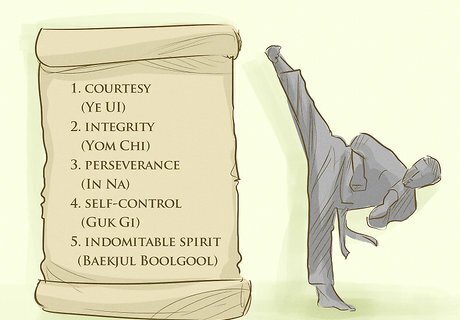
Learn the 5 tenets of Taekwondo. They are courtesy (Ye UI), integrity (Yom Chi), perseverance (In Nae), self-control (Guk Gi), and indomitable spirit (Baekjul Boolgool). Professional Taekwondo martial artists take these principles very seriously.
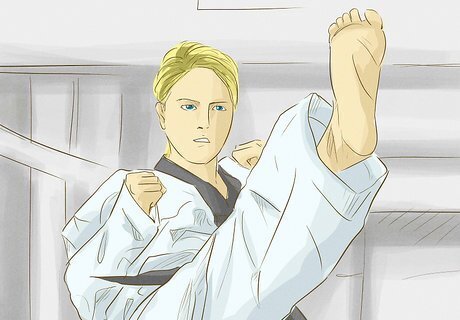
Hone your sense of discipline. Discipline means practicing your craft constantly, but it also means only using your martial art techniques in situations that call for it. Don’t be quick to fight. Find non-violent means to resolve conflicts. Truly great Taekwondo marital artists are dedicated to their practice. They practice their techniques and study Asian philosophies on a regular, if not daily, basis. If you want to be a great Taekwondo martial artist, you'll need to show the same level of dedication.

Avoid distractions. Taekwondo teaches its practitioners to avoid idleness, which breads boredom and contempt. Have goals for yourself and persevere in those goals. Find goals that benefit you and your community as a whole. While Taekwondo is not an evangelical movement, it does encourage its practitioners to set a good example for others and to be able to spread its message of discipline and peace.

Develop your manners. Taekwondo teaches you to avoid conflict whenever possible. This starts with your manners. If you enter a situation and immediately insult/offend someone, you’ll invite conflict. Be calm and respectful to everyone. Courtesy and mutual respect are central tenets of Taekwondo.
Preparing Your Body
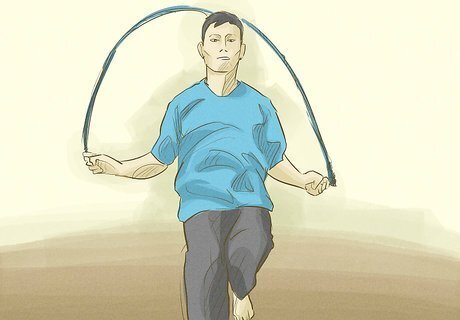
Always warm up. Before you start your training, begin with basic warm up exercises. You need to get blood flowing to your limbs and muscles so they can be in tip top shape. Jump-roping is one of the best ways to warm up because it increases your stamina as well. Other exercises include mountain climbers, squat thrusts, and running in place.

Stretch. Taekwondo is about taking your body to the next level. In order to be able to perform many martial arts moves properly, you need to be very flexible and limber. Trying to perform a high kick without stretching will most likely result in pulled muscles, which will hinder your ability to improve. The main part of your body to stretch are your ham strings. Since Taekwondo focuses primarily on the legs, you’ll want to be the most flexible there. Touch your toes and hold it for at least 1 minute. Then move on to your other lower body stretches like groin stretches, standing calf stretches, angle rotations, and crossed leg stretches. Conclude with core and upper body stretches like forearm rolls, triceps stretches, posterior shoulder stretches, and side stretches. Stretch on a daily basis. If you skip days often, your muscles will contract and lose their elasticity. Even if you aren’t going to the gym or dojang (the Korean name for a Tae kwan do school) everyday, be sure to take 15 minutes at home and stretch your arms, legs, and core.
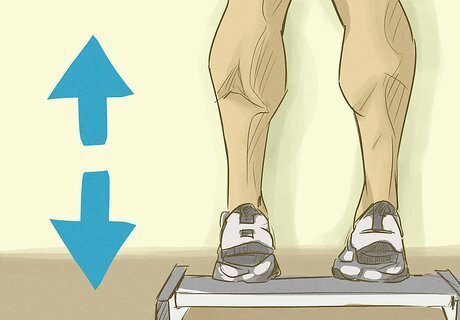
Get physically fit. Martial arts require the same level of fitness as any other sport. In order to get fit, you need to focus on your lower body, core, and upper body muscles. There are a lot of different exercises you can do, but you want to choose those exercises that replicate movements done in Taekwondo. For leg exercise, do calf raises, hamstring exercises, lateral jumps, leg extension exercises, leg presses, and squat thrusts. To exercise your core, do bicycle crunches, reverse crunches, leg raises, planking exercises, Russian twists, and normal sit-ups. To strengthen your upper body, do pull-ups, push-ups, bench presses, bicep curls, dumbbell flys, and chest dips.
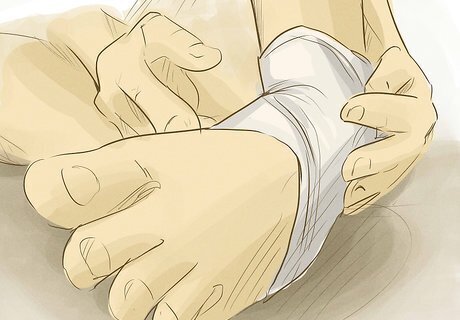
Take care of your body. Taekwondo is a contact sport and injuries happen. At the first sign of discomfort, stop and tend to your muscles. Do not practice while injured. Do not compete while injured. Taekwondo can wreak havoc on your muscle joints. After so many jumps, kicks, and punches, your knees, hips, elbows, and shoulders can become increasingly susceptible to wear and tear. The best way to take care of any muscle strain is to observe RICE: rest, ice, compression, and elevation.
Learning Taekwondo Techniques

Find an academy with a qualified Taekwondo martial artist. For a proper martial arts education, find a qualified coach or instructor. Do your research on the instructor themselves. Get references and check out his or her social media site. A lot of times, you can get a good idea of how “intense” a Taekwondo instructor will be based on their online presence. Check out yelp.com and other online sites where parents and students can post comments about a Taekwondo school and its instructors. Taekwondo is supposed to be a peaceful, defensive martial arts. Make sure that the instructor is World Taekwondo Federation (WTF) certified in Taekwondo.

Learn how to bow. The very first thing to learn when you start Taekwondo is the bow. The bow is a respectful greeting to your teacher and opponent. It reaffirms the notion that Taekwondo is a disciplined and respectful practice. Stand still on the ground with your feet close and your heels touching. Clench your fists in front of your body and then open your arms. You need to do this when you hear the command "Charyeot" (차렷). Lean forward when you hear the command "Gyeongnye"(경례).

Learn the language. Instructors and others in the Taekwondo community use specific names for stances and moves. Each technique has its own name. Some places use the original Korean name and others adopt an English equivalent.
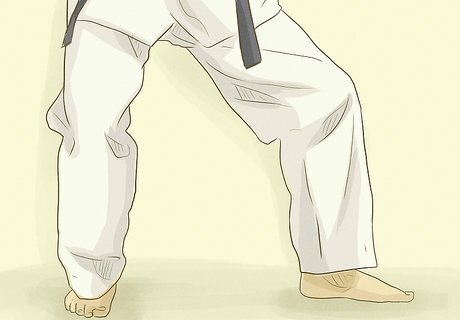
Work on your footwork. One of the most important skills a martial artist needs to master is their footwork. Stand in front of a mirror and practice shifting your feet forwards and backwards and from side to side. Make sure that you are taking quick compressed steps as opposed to long and slow steps. When in an actual match, your opponent will be looking for weaknesses and long, slow movements is a dead giveaway. When you feel comfortable with your footwork, throw in some fakes. Shift your weight in one direction and then quickly move in the opposite direction. When your opponent is watching your movement, this slight shift can make a big difference. After you’ve mastered fakes, try some kicks. All movements should be fluid and quick.

Learn to kick correctly. Taekwondo is set apart from other forms of the martial arts, because of its focus on footwork and kicks. In order to kick properly, you must pay close attention to both of your feet. One foot will be for striking. You need to have excellent aim, follow-through, and strength, but if your other leg doesn’t provide the base needed, your kick will be ineffective. Make sure that your non-kicking leg is firmly placed. You must be able to balance on that leg and to shift balance while you are kicking. Practice standing on one leg in front of a mirror. Hold that position for 1 minute. Then extend your other leg out as far as you can — either forward, backward, or to the side. Hold that position for 1 minute. Then switch legs. Balance on your other leg and extend the other out as far as you can. Hold for the same amount of time. A great Taekwondo artist needs to have the ability to kick with both feet, which requires excellent balance with both legs. Yoga is a great way to improve your balance and works very well with Taekwondo training.
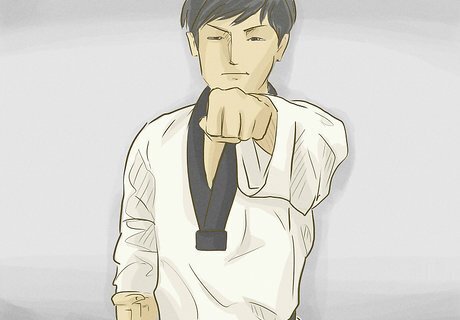
Learn to punch properly. While Taekwondo emphasizes leg work, you need to learn how to punch properly as well. Always keep your thumb on the outside of your hand. If you tuck your thumb inside, against your palm, and then make contact, you run the risk of breaking your thumb. Like with your legs, you need to pay attention to your base. Most martial artists will tell you that the real strength behind a great punch is not necessarily arm strength, but leg and core strength. As you throw your punch, be sure to set a solid base with your legs and twist your core in tandem, adding extra force behind your arm.
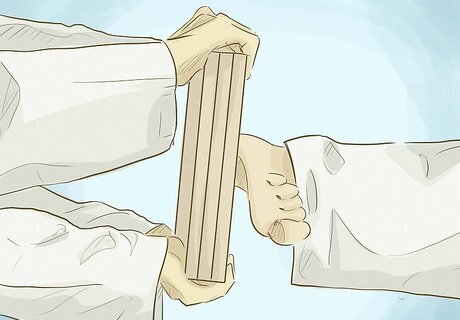
Practice your target techniques. Everyone wants to break boards on the first day of Taekwondo practice, but it takes time, patience, and practice to do so. You must concentrate on the exact spot you plan to hit. Then strike and follow through. Practice your form and technique outside of class (if you are taking one). Ask a friend to hold a board for you. Either just hit the board and have your friend pull it back at the last second or actually try to break it. Hang a kicking board attached to a bungie chord from the ceiling and practice kicking or hitting it in a particular spot. You won’t break it, because it will recoil and swing around, but you’ll be able to hone your accuracy and increase your strength.
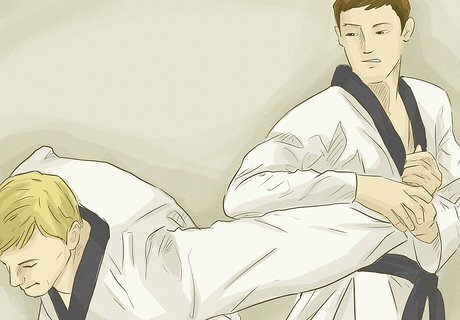
Study and practice self-defense techniques. So much of Taekwondo is about maintaining peace. Some even say that Taekwondo is synonymous with self-defense. There are numerous self-defense strategies you should practice. If someone has you in a “bear-hug” from behind and your arms are immobilized, stomp on the attacker's foot to distract him and then step back aligning your hips next to his and then bend forward quickly. This should break the attacker's hold over you and even possibly flip them over, giving you time to escape or to prepare to fight. If your attacker has you by the wrist, start with a front kick to the body or groin and then quickly turn your wrist until the attacker’s thumb and fingers are facing you. The attacker’s grip will be loosed at this angle and you should be able to pull away easily. There are numerous other self-defense techniques that a Taekwondo teacher can show you. "Bear-hugs" and wrist grabs are just two of the most common self-defense situations.
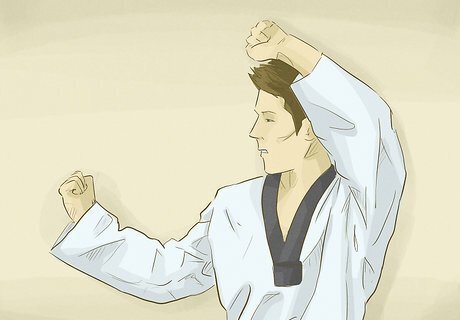
Master your forms. Forms, also known as "hyungs" in Korean, are sets of offensive and defensive maneuvers performed on imaginary opponents. They are basically choreographed martial arts moves that people use to practice basic techniques and transitions. At most Taekwondo dojangs, you will need to show mastery of several forms before you can progress to the next stage or receive your next belt. forms Remember that forms are all about form. Make sure that you are not simply moving from one move to another. Pay close attention to your footing and arm and leg movements.

Spar. Once you have achieved a degree of mastery, you will be able to start sparring. Find a partner, who has achieved a similar level of training. You should spar in a controlled and safe setting. At first, sparring will be like practicing your forms with another person. Later, you will really spar. This will entail attacking each other and countering each other’s moves.
learn how to kick and punchkicks and Punch




















Comments
0 comment